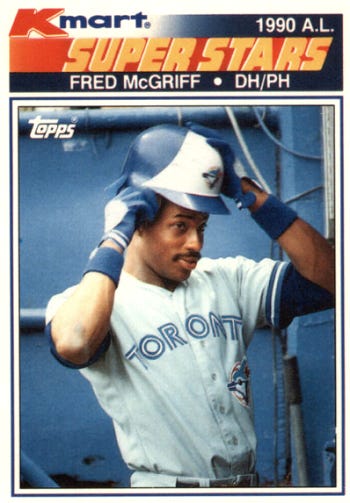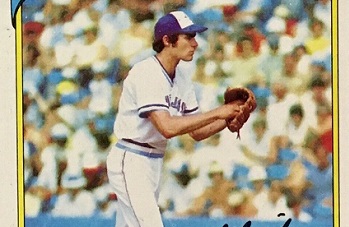Sometimes, you can trace the beginning of monumental changes to one simple decision.
Like when Al Pacino turned down the role of Han Solo, and we were stuck forever wondering who shot first — the answer would have been obvious with Pacino in place.
Or that time you decided to buy yourself another ice cream at the county fair instead of using the money to buy Betty Jean Robbins a ride pass to ride with you, because you were fifteen and hungry, and how were you supposed to know she really did like you or that she’d grow up to be a district judge?
A little closer to home for us, how about that time Kmart changed their logo and approach to baseball cards? You know, in 1990?
Because, up until that time, Kmart had been one of the preeminent big-box department stores in the country for nearly thirty years, and they had cemented that status with card collectors during the 1980s with a couple of sets that featured turn-back-the-clock type motifs.
First up, of course, was the 1982 set that displayed miniature versions of Topps cards for each of the MVPs since 1962.
Then, in 1987, Kmart went for “stars of the decades,” this time featuring vintage photos of the big names in question.
In 1990, though, at the head of a new decade and facing big competition from the likes of Walmart and the internet (whether they knew it or not), Kmart undertook an image makeover.
Find Fred McGriff cards on eBay (affiliate link)
Find Fred McGriff cards on Amazon (affiliate link)
New logo.
Supercenters.
Deals with Martha Stewart and Kathy Ireland.
European stores.
All would come to pass — and some to pass away — before the ‘90s were finished.
Right at the outset, Kmart made another decision — they issued another baseball card set.
This time, though, there were no Topps throwbacks, no old-time images, no all-time greats (well, not a ton of all-time greats, anyway).
No, instead, Kmart rolled out a 33-card set of Baseball Superstars, featuring the likes of Jose Canseco, Tony Gwynn, Nolan Ryan, Dwight Gooden, and a few “lesser” names like Joe Magrane and Jeff Ballard.
So … how did Magrane and Ballard get mixed in with the future Hall of Famers and the lockdown super-duper stars of the day?
Well, those guys were stars in a way, certainly among the best on their own teams. And the presence of a manager card suggests maybe we’re looking at an All-Star lineup of some sort.
For sure, Tony La Russa and Roger Craig managed the AL and NL squads, respectively, in the 1990 Midsummer Classic, but Magrane and Ballard never did garner AS designations.
So, maybe Topps and Kmart were just making a guess as to which players would make the 1990 squads based on previous results. Wishful thinking, maybe.
No wishful thinking needed for card number 31, featuring Fred McGriff, though.
Well, sort of.
Crime Dog was already a bona fide star by that point, finishing among the American League leaders in home runs and RBI for the Toronto Blue Jays in 1988 and 1989. But … he had yet to garner an All-Star berth for his efforts.
But, just as with Kmart, things were about to change for the Jays and for McGriff,
Because, in December of 1990, Toronto sent their slugger, along with shortstop Tony Fernandez, to the San Diego Padres in exchange for Roberto Alomar and Joe Carter.
It was a sort of multiplayer challenge trade — your big bat and middle infielder for ours.
Of course, that move paid off for the Blue Jays in 1992 and 1993, when Carter and Alomar help them win two World Series in a row leading into the The Strike of 1994-95.
Fernandez turned in a couple of solid seasons for the Pads before moving around among six franchises, including Toronto, to finish out his career from 1993 through 2001.
And McGriff continued his homering, run-driving-in ways in San Diego, even leading the National League in dingers with 35 in 1992 — no mean feat for the Padres, who typically homered at or below league-average rates.
He made his first All-Star team that season, too.
The next summer, though, San Diego sent McGriff to the Atlanta Braves in a trade deadline deal, setting the stage for him to win his only ring a couple of years later.
Stops in Tampa and Chicago (Cubs) saw McGriff continue All-Star-level performance for the most part, through about 2002. He wound up his career at ages 39 and 40 with the Dodgers in 2003 and a return to the Devil Rays in 2004.
When you add it all up, McGriff tallied 493 home runs and 1550 RBI to go along with a solid .284 batting average.
Alas, in ten trips through the Hall of Fame voting process, McGriff never cracked 40% of the ballots, but there is some sense that an extra seven home runs would have made him a more attractive candidate.
So, would 500 homers have made McGriff a Hall of Famer?
And, more to our point here today, would McGriff have added those seven dingers if he’d stayed in Toronto through their World Series years? Or would he have tallied even fewer longballs?
We’ll never know the answers for sure, but we do know that things were never the same for either Crime Dog or Kmart after he appeared in a Jays uniform on that 1990 Baseball Superstars card.
And it all started with one (or two, or a million) little decision(s).
Wow! Wax of the Day
Surprise! You can still find plenty of 1990 Kmart cards out there for sale today, like this lot on eBay.
It’s a complete 24-set display box, with each set still cello-wrapped. And each one still has the bubble gum. What’s not to like about 30-year-old confections?
Check out the full listing right here (affiliate link).

1990 Topps Baseball Cards Complete Your Set U-Pick (#'s 201-400) Nm-Mint
 | $0.99 End Date: Thursday 05/02/2024 13:26:38 EDT Buy it now | Add to watch list |
1990 Topps Baseball Cards Signed Complete Your Set AUTOGRAPHS
 | $2.39 End Date: Thursday 05/02/2024 20:07:46 EDT Buy it now | Add to watch list |
1990 TOPPS BASEBALL CARDS ( HENDERSON,WITT,VALENZUELA,McGWIRE)
 | $3.75 End Date: Saturday 05/11/2024 20:00:42 EDT Buy it now | Add to watch list |
1990 Topps Baseball Cards Lot Of 70 Cards #106
 | $3.99 (0 Bids) End Date: Thursday 04/18/2024 11:06:02 EDT Bid now | Add to watch list |
1990 Topps Baseball Cards Complete Set
 | $3.25 (3 Bids) End Date: Sunday 04/21/2024 11:30:19 EDT Bid now | Add to watch list |
1990 Topps Baseball Cards : Complete Your Set U-Pick : #'s 101-199
 | $0.99 End Date: Tuesday 05/07/2024 10:33:09 EDT Buy it now | Add to watch list |
1990 Topps Baseball Cards, 4 Unopened Wax Sealed PACKS, 16 Cards Per Pack
 | $8.99 End Date: Monday 04/22/2024 20:30:19 EDT Buy it now | Add to watch list |
1990 Topps Baseball Cards Picture Cards Vending Box of 500 Cards NMMT
 | $11.77 End Date: Wednesday 05/15/2024 16:34:12 EDT Buy it now | Add to watch list |








Recent Comments